Author: erkan

Information About Topkapi Palace Museum
Information About Topkapi Palace Museum,
THE HARNESS STORE
This single domed building of the fifteenth century was set aside to house the magnificent saddle sets of those times, made of gold and silver set with emeralds and rubies. This is also known as the Ifraz Hazinesi. In recent times it was converted into a mosque, but having now been restored it is used to exhibit saddles, bridles, stirrups and camel covers from the eighteenth century onwards. Documents in the archives reveal that older jeweled saddle sets were ruined by having the precious stones removed. Jeweled headstalls and whips remaining from these are exhibited here.
MOSQUE OF BESHiR AGA
The building next to this mosque has been destroyed, and only the flue of its bath has been preserved.
THE BATH OF THE BALTACILAR (HALBARDIERS)
In front of this is the Meyit Gate. Past the mosque, the coach gate of the palace stables can be seen. On the way to the Middle Cate, which leads into the museum, on the portico to the left, a number of fountains and selsebil marbles from different parts of the palace grounds, marble columns and pieces of the column, hearths, etc. have been grouped together. Here can be studied the changes undergone by Turkish architecture in various ages: classical, baroque, rococo, and Empire. This collection will be added to from time to time, form the nucleus of an architectural museum.
It ill be seen from this brief introduction to the treasures of the Saray that history inhabits every corner of those many structures and that each building the expression of a different form of art. Here tit t has great Museum tens of thousands of works of art hold of priceless books, manuscripts, and state archives went on display. The depots are filled with much more will be brought to light as the occasion presents itself. This Museum is a treasure house not only of Turkish art but, also of the art of a great many countries, beginning with China. There is a great variety of works of art here that will appeal to every taste so that the Saray Museum provides an amazing field both for tourists and for research students from all over the world.
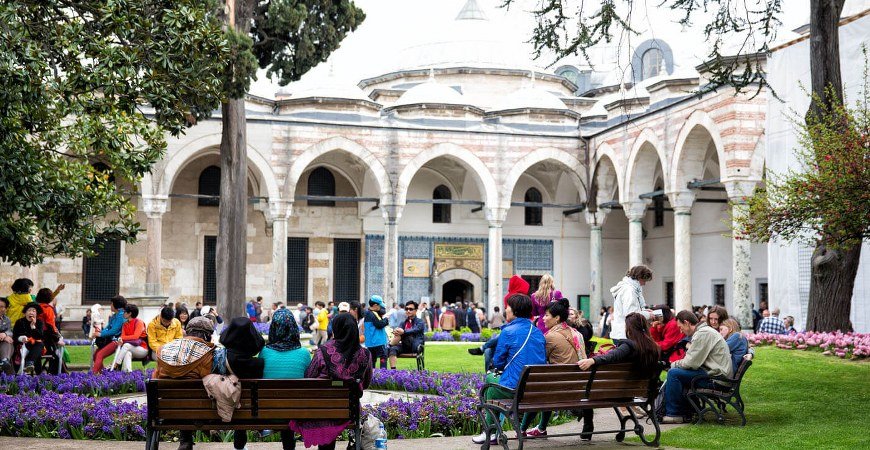
About Topkapi Palace Istanbul
About Topkapi Palace Istanbul,
SECTION OF CHINESE AND JAPANESE PORCELAIN
The Ottoman rulers prized Chinese porcelain and from very early times, through gifts, booty or purchase, collected vast quantities of it. More than ten thousand pieces remain, and six thousand of these are on display in chronological order. A few go back to the Tang period. The great majority are of the Sung and Yuan dynasties, that is of the ninth to the fourteenth centuries. This is undoubtedly the largest collection in the world, both in numbers and in the variety of styles represented. In one and the same room can be seen Ming porcelains of the white, colored, emperor yellow, and blue-white varieties. Five hundred pieces, which, after their arrival in Turkey, were ornamented with rubies and emeralds set in gold, constitute a unique collection. Next come porcelain of the fifteenth to the seventeenth centuries, ()I’ the blue-white, pink and green kinds, the inscribed specimens being particularly of note. The last section consists of porcelain of the eighteenth century, of the blue-white, pink, buff and dark blue shades. In the same hall are exhibited Japanese porcelain of the seventeenth and eighteenth centuries.
SECTIONS OF EUROPEAN PORCELAIN AND CRYSTAL
Various sets of Vincennes, Limoges, Sevres, J. P. and other French porcelain are displayed in series. Of special note are the dinner sets made to order for Turkey. Next to the French is the Russian porcelain, then pottery dinner sets made in Warsaw and decorated with Turkish writing. Among the Berlin, Meissen and Vienna porcelain, are many rare pieces of unusual shape and design made to order for the Ottoman market? Examples of Irish, Venetian and Bohemian crystal glassware and crystal candelabra are to be seen in the same hall. The porcelains exhibited in this hall represent almost all the known existing varieties, from the earliest Chinese to modern European. Moving from case to case, the visitor goes on a journey around the world: the special characteristics of the porcelain art of each country are displayed here.
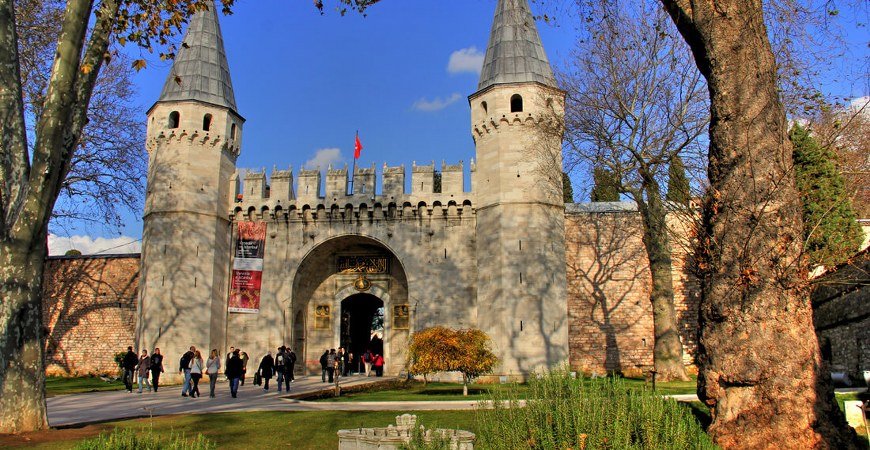
The Middle Gate of Topkapi Palace Museum
The Middle Gate of Topkapi Palace Museum,
This gate, known as Bab’i – Selam, or Gate of Salutation, acquired its twin turrets during the reign of Suleyman the Magnificent. Above the two doors of gilt wrought iron is inscribed the date 1524. Research has brought to light the fact that this gate was completely different in the period of the Conqueror. It was customary for the viziers to alight from their horses outside the gate; only the sultan could go through on horseback. Statesmen have been known to be imprisoned in the little gloomy cells inside the two towers. Beyond the gate is a roofed and broad-leaved exedra, built in the eighteenth century. This leads into the second court, the House of Salutation. The first path to the left led to the imperial stables, the second to the Harem, and the third to the Kubbealti, under the Dome, the building where meetings of the Divan took place. Walking along this path the viziers received salutations at fixed intervals. The fourth path was reserved for the use of palace officials, and the fifth, broader than the rest, for the sultan himself. The paths to the right led to the imperial kitchens. Most of the cypresses in this courtyard were planted in the time of Sultan Reshat Mehmet V and the courtyard itself was greatly modified at the same time. On the right-hand side of the second courtyard is a portico with three doors opening from it.’ These doors lead to what remains of the cooks’ living quarters’ and gardens. The I Hams originally consisted of a building with four domes constructed in the Conqueror’s time. Six more domes were added by Suleyman the Magnificent, and after the kitchens were damaged by fire in 1574 the architect Sinan added ten conical domes and redecorated the kitchens. At one time the cooks and their assistants numbered 1117, and the huge kitchens were a factory for the making of jams, sweets, pickles and oven perfumed soap. With time the hearts were extinguished, the chimneys stopped smoking and these buildings fell into ruin. They were repaired in 1938 -39 and it then became possible to exhibit here to the public precious Chinese and Japanese porcelains, European crystal and dinner services, the palace silver and copper dishes and countless other precious objects of a similar nature.

Places to Visit in Cappadocia Turkey
Places to Visit in Cappadocia Turkey,
Uchisar
Uchisar is a small town (pop. 3500) near the Nevsehir- Urgup highway (1 km) and is almost halfway between these two towns. Originally the houses were built around the citadel, but, owing to the effect of erosion and to an increase in its population, they came to be built lower down the hill. Nowadays the citadel of Ughisar is surrounded by houses. It has a cave cut out of the rock approached by three different corridors which all reach a large central hall. One of the corridors has a stone door with a guard-rood behind it. Besides these, there are other rooms and corridors and some of them are filled with earth and rubble and the roof has fallen in.
The chief attraction of Ughisar is the citadel from where one has a superb view of the whole Goreme valley and is therefore warmly recommended to enthusiasts of photography. In 1969 a hotel was built at Ughisar into the rock; in its rooms, one has wine on tap! This establishment has contributed greatly to the tourism of the region. Besides vineyards, carpet-weaving and other handicrafts are the main occupations of the inhabitants.
Cavusin Village
When you go 3-4 km. on the Nev§ehir-UrgOp road after you go 10 km. on the Ughisar road on the left, you get to the cav4n village. This village is famous for the houses of Christian priests and churches. The churches were generally made between 7th and 10th centuries. Some of these are at G011udere and Kizilgukur locations and some of them are called pigeon houses by the village people today. One of the most important and interesting places is the Basilica type church carved into the rocks on the graveyard. It was made for St. John. Although the front part wore from erosion, the ornamented pole at the church remained in place. There is another church named Pidgeon House in the direction of the Avanos Village exit. The front part of this church was also demolished from erosion just like the other and some of the frescoes remained buried. You can go up to the real church section which has more frescoes by an iron ladder added later, to the demolished facade. The church does not have pillars and its ceiling is arch shaped, it has a large apsis in the middle and two small apses on the sides. This church represents the life of Jesus Christ and the words of the Gospel mostly. The colors used in the frescoes are generally brown and green. There is a monastery just near this church and there are four carved graves inside it.
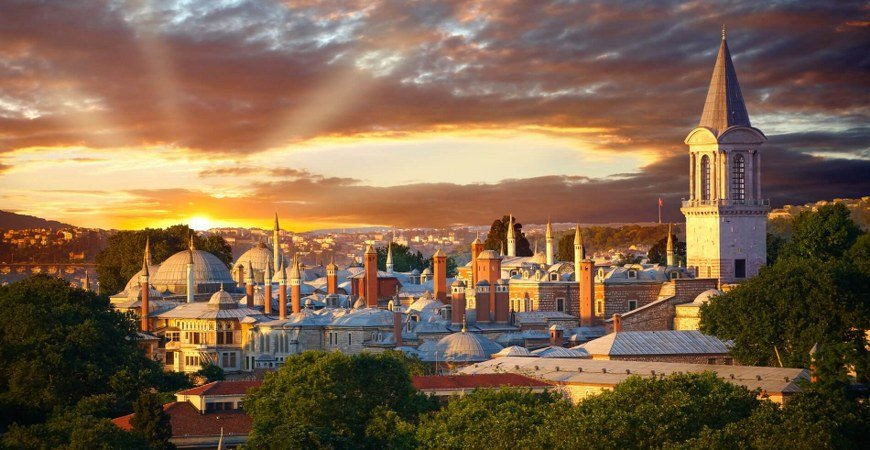
A Short Historıcal Sketch of Topkapi Palace Istanbul – Chapter 2
A Short Historıcal Sketch of Topkapi Palace Istanbul – Chapter 2,
A peculiarity of the Saray is precisely the variety of architectural styles from the fifteenth century to the beginning of the nineteenth which the numerous beautiful buildings within its crenelated walls exemplify. The like of this agglomeration does not exist anywhere in the world and it is a veritable treasure house for students of the history of Turkish architecture. Nowhere else is it possible to find, within one enclosure, the wealth of detail in plan and style, of stone and wood carving, of ceiling decoration and tile designs, or even of the ingenuity displayed in kitchen hearth and water conduit, as exemplified here in kiosk, treasury, mosque, harem, dormitories, the Divan Court, Hall of Petitions, court of justice, library, school and kitchen.
The aim of this booklet is to acquaint the new I. with these buildings of five centuries, and to polio out at the same time the Byzantine works which re to be found within the same enclosure.’ The pages that follow will also contain a description of the treasures which have found their way from the four corners of the earth into the treasure roone4 of this five-century-old Turkish palace, which has provided a setting for so many historical events, via stories, revolts, palace intrigues and adventures. These many treasures have been classified, and several sections of the Museum are devoted to them. Mention will also be made of the archives housed in the Museum, containing thousands of priceless manuscripts covering the history of the Ottoman Empire from its birth. It stands to reason that these many aspects of the Museum cannot be dealt with in thorough detail in a small guide of this nature. A complete description of the contents of this Museum would run into several volumes. We feel very strongly that mere words can not adequately describe to the prospective visitor works of art which he has not yet seen; therefore our aim is to be as brief as possible, merely pointing out the way to these masterpieces, then letting them speak for themselves. It is a great pity that most of these historical structures outside the body of buildings known to – day as the Saray Museum, except for the Sultans Fortifications, the Tiled Pavilion (Cinili Kosk), the Pavilion of Processions (Alay koskii), and the Pavilion of the Basket – Weavers (Sepetciler Koskii), are in a state of 7 disrepair or have been burnt down by fires. Sometimes it is impossible to state with certainty where their position was.

A Short Historıcal Sketch of Topkapi Palace – Chapter 1
A Short Historıcal Sketch of Topkapi Palace – Chapter 1,
In 1454, the year after the conquest of Constantinople, Mehmet II Fatih, that is the Conqueror, built his first palace in the Forum of Theodosius, where the Istanbul University is situated today. Jt was only some time after this that the Conqueror built his New Palace, the present Saray Museum, on the point of the city where the Byzantine Acropolis was situated. The earlier construction then became known as the Eski Saray, or Old Palace. This corner, which was once known as Zeytinlik because of the groves of olive trees which covered it and which is now famous as Saray Point, can truly be described as the most beautiful spot in a city distinguished amongst her peers for exceptional natural beauty. From this magic point, where the Mar-mara, the Bosphorus, and the Golden Horn come together, the eye sweeps over every part of the city, and out to the Princes Islands beyond. The towers and domes, the chimneys and columns of the Seraglio stand out like a majestic crown set upon the hill. They form a beautiful pattern whether viewed from sea or land and once seen can never be forgotten. The New Palace was built to a plan which tradition had already established for the abode of Turkish rulers. It grouped around a series of courtyards and gardens not only the living quarters of the sultan but also accommodation for the more important departments of state, and kiosks and other buildings housing the sultan’s entourage, each series of structures being in different style, the whole an expression of mature all Topkapi Palace, built in the years 1472 — 1478, is surrounded on the land side by a system of walls and towers which is known as the Sultans Fortifications, which connect on the seaside with the old Byzantine fortifications.1 The space enclosed by these walls is 699,000 sq. metres. Originally the New Palace was built to house the retinue of the Conqueror. The growing household of his son Bayezit necessitated the addition of a new kiosk, and from then on constant additions and alterations were made, especially during the reign of Suleyman the Magnificent (1520 — 1566), by which time the sultan’s household included five thousand souls. Last in the series of additions was the building constructed in the French style of the early nineteenth century in the reign of Abdul Mecit.
You can find more details about A Short Historıcal Sketch of Topkapi Palace in Chapter 2.
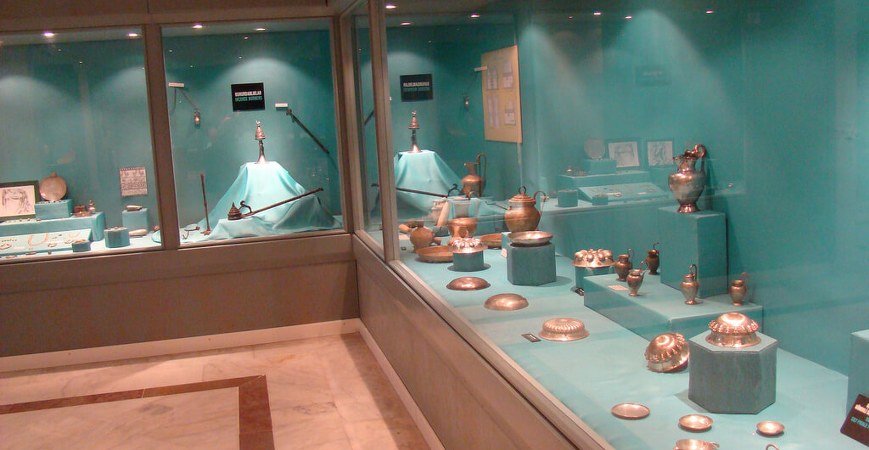
Usak – Van – Zonguldak and Amasra Museums
Usak – Van – Zonguldak and Amasra Museums,
USAK MUSEUM
Steps to establish a museum in Usak only began recently. Construction of a museum building began in 1967 and was completed in 1970. Works from the region of Usak and works brought from Ankara and Istanbul were exhibited in the new museum.
Usak Museum consists of two sections. The first contains various works dating from the prehistoric ages to the end of the Byzantine period, clay pottery, vases, lamps, figures, tear bottles, Phrygian period works, Roman period grave steles and statues, and findings from the Selcuk excavations. The second section contains Ottoman period works, including carpets and kilims, copper kitchen utensils, porcelain, wooden and metal works, ornaments, embroidery, and clothing. The garden of the museum contains statue pedestals, column capitals, and stone bas-reliefs.
VAN MUSEUM
Gathering of archaeological and ethnographic works from the region of Van began in 1932 when they were stored in a room at the General Directorate of Education. In 1947 these works were moved to a barracks at a school.
The museum was enriched with findings from the excavations at Toprakkale, Cavustepe, Patnos, and Adilcevaz in the Van region after 1959, and no existing building could be found that was suitable for exhibiting the works. So in 1968 construction of a new museum building was begun, and completed in 1971. The works were exhibited and the new museum opened to the public in 1972.
Van Museum consists of two exhibition rooms, one downstairs and one upstairs. Archaeological works are exhibited in the ground floor room and include Urartu works uncovered by excavations at Patnos, Toprakkale, Cavustepe, and Giyimli. On the top floor are various ethnographic works from the region of Van, and findings from excavations at the old city of Van and Ulucami. The garden of the museum contains inscriptions from the Urartu period.
ZONGULDAK – AMASRA MUSEUM
In 1945 a museum depot was established in Amasra in the Zonguldak sub-province of Bartin. In 1959 these works were temporarily exhibited. The museum contains archaeological and ethnographic works of the region.
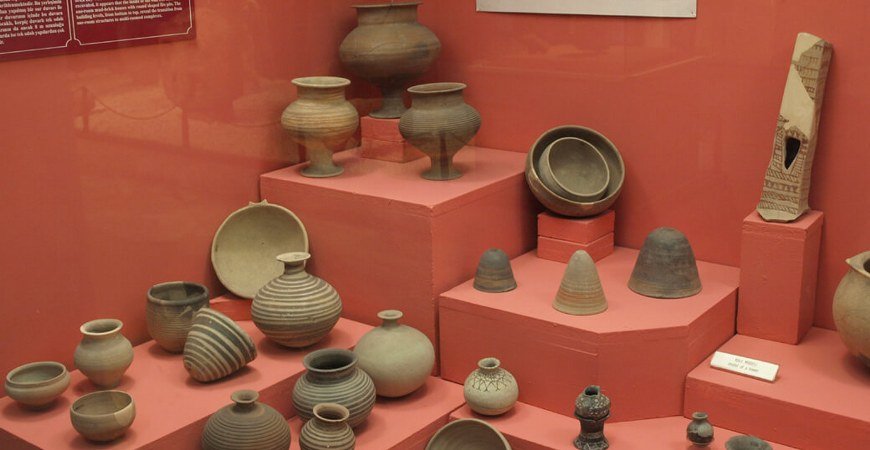
Urfa Museum and Tokat Museum
Urfa Museum and Tokat Museum,
URFA MUSEUM
The first museum depot was established in Urfa in 1948 in a room of a primary school. In 1956 the objects were moved to the ground floor rooms of Sehit Nusret Primary School and put on exhibit. When these rooms became too small a new museum building was begun in 1961, the works moved here when it was completed in 1965, and the new museum opened to the public in 1968. Urfa Museum consists of two eXhibition rooms. The small room to the right of the entrance contains statues, steles, column capitals, bas-reliefs, sacrificial altars, and masonry. The large room contains ceramics and small metal, bone and stone objects from the prehistoric ages to the Greek, Roman and Byzantine periods, pieces of mosaics from Urfa Necropolis, excavation findings from Harran-Sultantepe, and ornaments. One section of the room contains ethnographic and Islamic period works, including manuscripts and inscriptions, carpets and kilims, metal jewellery etc.
The garden of Urfa Museum contains columns and capitals, friezes and pieces of statues, grave steles, inscriptions, clay water jars, Seljuk and Ottoman period inscriptions and gravestones found in Urfa, Viransehir, Nizip, Harran, and Yarimtepe.
TOKAT MUSEUM
Tokat Museum was established in 1926 in the Seljuk period Gokmedrese in Tokat. The Gokmedrese was a Seljuk hospital, built in 1275 by Emir Suleyman Pervane. The medrese has two stories, an open courtyard, colonnades, and exedras. The inner walls of the courtyard used to be covered with tiles. The museum contains ceramics, sarcophagi, statues, grave steles, glass objects and masonry dating from the pre-Islamic period found in the region of Tokat, clothing and embroidery from the To-kat region, tekke objects, axes, tambourines, flutes, items, standards etc., Roman, Byzantine, Seljuk and Ottoman period coins, gravestones from Tokat graveyards, stone inscriptions, and various ethnographical objects. Tokat Museum also has an archive which contains Canonical Records of the Tokat and Amasya regions.
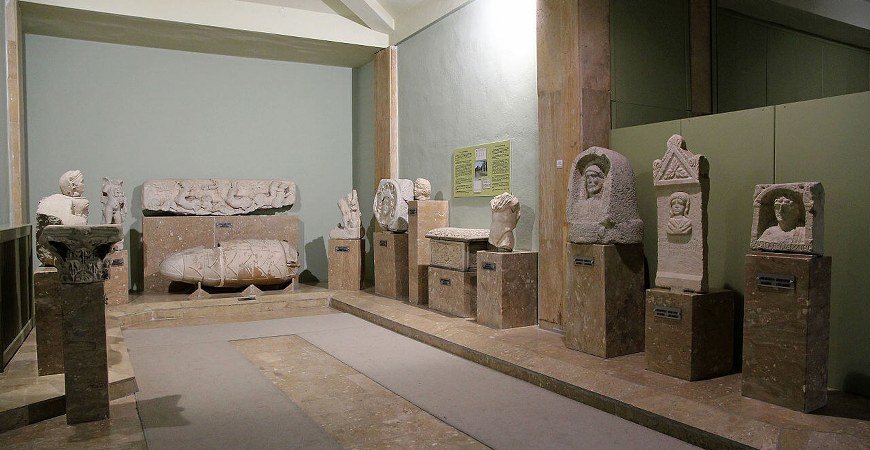
Nigde Museum and Tekirdag Museum
Nigde Museum and Tekirdag Museum,
NiGDE MUSEUM
In 1936 archaeological findings and ethnographic works from the region of Nigde were stored in the Akmedrese in Nigde, which was built during the Karamanoglu period. After a short time, the works were put on exhibit in the courtyard and rooms of the Medrese thus establishing Nigde Museum.
The Akmedrese was built in 1409 by Alaeddin All Bey of the Karamanogullari. It is in the Seljuk open courtyard style with an exedra. Because the portal is covered with white marble it is called the Akmedrese (white Medrese). The museum rooms contain written documents of the Hittite period, steles, statues, masonry, tear bottles taken from graves, lamps and bronze and gold objects from the Roman-Byzantine periods, gold, silver and bronze coins from the Hellenistic to Ottoman periods, carved wooden doors from the Seljuk period, a steel safe and box, embroidered napkins and waistbands, clothes, coffee services, spoons, keys, clocks, weapons, knives, and a mummy thought to date from the IX-X centuries. In the exedra is a hair tent belonging to a Turkmen tribe which lived in the region of Nigde. In the garden is exhibited masonry from the Roman-Byzantine period, styles, inscriptions, and Islamic gravestones. A new modern museum building is being built in Nigde at the present time.
TEKIRDAG MUSEUM
Steps to establish a museum in Tekirdag have only recently begun. In 1967 works from the region were temporarily exhibited in the rooms of the Tekirdag Naval Club. The museum works include plant and animal fossils from the paleontological ages, prehistoric findings, pottery, stone instruments, masonry, inscriptions, grave steles, column capitals, statues, clay figurines, pitchers, amphoras, glass objects, coins etc. from the Greek, Roman and Byzantine periods. Tekirdag Museum also includes a section of Islamic period works and ethnographic works from the region. This section contains embroidery and weaving, jewelry, copper objects, regional costumes and Ottoman period inscriptions.
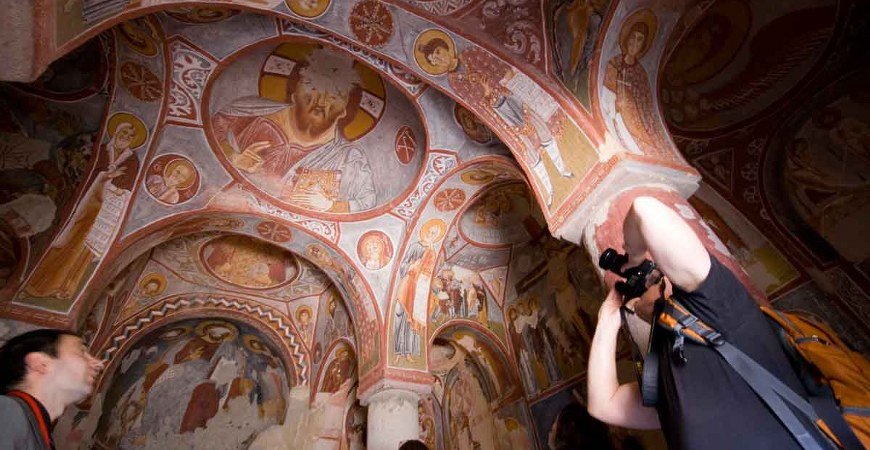
Cave Churches in Goreme Open Air Museum Cappadocia
Cave Churches in Goreme Open Air Museum Cappadocia,
Church With A Snake (Yilanli Kilise)
One of the interesting churches in Goreme is the Church with a Snake. This church does not have pillars and domes. It has an arch shaped ceiling and the pictures are made on the sides of it. There is also a grave in the Church. You can see Constantine and Helen holding the Cross with their left hands on the left walls of the entrance. The picture near this shows the fight of St. George and St. Theodore and there are pictures of St. Basil, St. Thomas and Onouphrios on the right side. According to the saying: Onouphrios was a very beautiful woman and was bored with men distracting her, so she prayed God for her salvation. God answered her praying and gave her a beard and she became ugly. You can notice that she appears as a man and half a woman.
Church With A Buckle (Tokali Kilise)
It is the biggest church in this region. built in the 11th century. It is called the Church with a Buckle because it has a buckle on the ceiling. Even though this buckle disappeared for unknown reason its location is still evident. There is a big apsis across the entrance and two small asides on the sides. On the sides and in front of the apsis, there are four pillars. More pictures were made in this church because it is wide and large.
The pictures mostly symbolize the miracles accomplished by Jesus Christ. The pictures in the church are the following: A picture symbolizing Gabriel announcing to Mary that she will bear the Christ, the exodus of Joseph, Mary and Jesus to Egypt, Yahya (John the Baptist) baptizing Jesus, Lazarus’ resurrection, the Last Supper, Jesus’ crucifixion, Jesus being taken down from the Cross, the treachery of Judas, one of the Apostles and many other paintings.